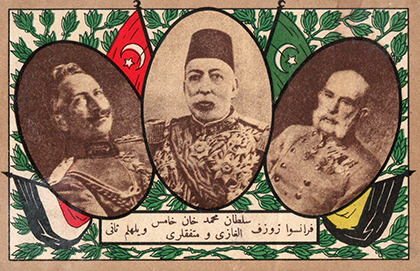16.04.2016

The Armenian Genocide, which was the culmination of Turkish anti Armenian state policy, began under the cover of World War I. Today, on the base of the Turkish state history and historiography lays the principle of denial, which aims at presenting the Armenian Genocide as a consequence of war, not a result of carefully planned program.
However, many documents from the different countries’ diplomatic archives clearly state the existence of a purpose of the planned and consistent destruction of Armenian people.
The telegraphic reports and reports of the allied German and Austro-Hungarian diplomatic and military figures deployed in the Ottoman Empire are very important from the side of revealing the question of the Turkish state responsibility.
German and Austro-Hungarian diplomats continued their activity after the entry of the Ottoman Empire in the war. The examination and comparison of their reports shows that the World War I was an opportunity and not a cause for the Armenian Genocide of 1915-1923.
The German military mission arrived in the Ottoman Empire early in December, 1913 and during the military operations had about 7-8 thousand officers and 12 thousand soldiers. This made the German military presence huge in the country. Thus Ismet, one of the Turkish generals, even complained that German military mission was allowed to follow to the daily events in the country and the Germans were entrusted with all state secrets, both political and military. Particularly, the Second (or intelligence) department of the Ottoman army’s General Staff was led by a German officer. This indicates the high level of awareness of the German military figures and, consequently, of the diplomats too.
At the beginning of 1915 based on the Turkish officials’ expressions and illegal activities in their regions, the allied diplomatists in the Ottoman Empire, stated the planned and approved state’s internal policy course of the extermination of the Armenian people. German and Austro-Hungarian diplomats' reports covered entire territory of the Ottoman Empire. Consuls and Vice-Consuls functioning in the Empire informed their Ambassadors and the Ministries of Foreign Affairs about the massacres of deported Armenians and its consequences with telegraphic reports inscribed "secret" or "top secret". In the reports German (Scheubner-Richter, Rössler, Hoffmann, Büge, Holstein, Kuckhoff, Werth, Bergfeld) and Austro-Hungarian (Kwiatkowski, Radimsky, Nadamlenzki) diplomats from Alexandrette, Adana, Samsun, Mosul, Smyrna, Sebastia, Trabizon, Erzurum, Aleppo and from other regions of the Ottoman Empire, identified the deportation of the Armenian population and their massacre as equal methods of extermination. The combination of these reports reveals the barbaric nature of the deportations.
The authenticity of the Austro-Hungarian and German documents is out of doubt because, in war condition the official reports of ally states of the Ottoman Empire, could not be in favor of Armenians. Moreover, there is another feature that gives credence to the German sources. The authors of these reports and telegraphic messages basically did not have a positive opinion about the Armenian population of the Ottoman Empire, and sometimes they had a negative attitude towards them. Thus, in April 1915 Ambassador Wangenheim wired to Berlin that the condition of Armenians was quite hopeless and the interference contradicted to Germany’s state interests, and claimed to Morgenthau at the same time that Armenians are just insidious vermin.
Besides, the high level of diplomatic confidentiality was increased due to the war conditions. Consequently, the German and Austro-Hungarian diplomats being sure of privacy of their correspondence were not constrained while writing their reports.
Representatives of the diplomatic staff of the two countries were deployed in the Ottoman Empire for many years, had been in close contact with the Armenian population, well aware of the situation, the Armenian involvement in the economic life of the Empire. For all these reason they easily contradicted the Turkish versions of the Armenian rebellion, and revealed the real purpose of deportation and the probable economic disaster in Empire after the destruction of the Armenians.
Although the German diplomats and consuls were sending numerous telegraphic reports to Berlin, with detailed description of large-scale massacres, however, the government’s directive was clear: not to interfere and to keep the privacy.
The diplomatic staff
Ambassadors and temporary deputizing for them
German
• Baron Hans von Wangenheim,25 October, 1912 - 1915
• Prince Wilhelm Hohenlohe - Langenburg, 20 July – 2 October, 1915
• Baron Konstantin von Neurath, deputizing as Chargé, 25 October - 15 November , 1915
• Earl Paul von Metternich, 15 November, 1915, 3 October, 1916
• Wilhelm von Radowitz, deputizing as Chargé, 3 October -16 November 1916
• Dr. Richard von Kühlmann, 16 November, 1916 - 24 July, 1917
• Earl Johann Heinrich Bernstorff, 7 September, 1917 - 27 October, 1918
• Waldburg, deputizing as Chargé, 27 October - 20 December, 1918
Austro-Hungarian
• John Markgraff Pallavicini, 5 October 1906 - 30 November 1918
• The Acting Karl Count Trautmannsdorff - Weinsberg, replaced Pallavicini when the Ambassador was on a leave to Vienna, September 1915
Consuls and Vice Consuls
German
• Dr. Heinrich Bergfeld, consul , Trabzon, 8 March 1910 - 1916, after Consulate’s move to Samsun, 8 March 1916 , 27 January 1917, July - November 1918
• Dr. Eugen Büge, Consul, Adana, May 1910 - October 1918
• Hesse, Consul, Sebastia, 8 October 1917 - August 1918
• Walter Holstein, Vice Consul, gerent, Mosul, April 1911 - 1918 , was absent from work on inspection tours in November 1914 - December , October 1915, 22 July 1916 - 23 September
• Hermann Hoffmann, Vice Consul, Gerent, Alexandrette, 10 May - 10 August 1917
• Kuckhoff, Vice Consul, Samsun, August 1905 - 1917, Gerent, August 1917 - 7 January 1918, Gerent, Trabizon 27 Jan - August 1917
• Dr. Max Erwin von Scheubner-Richter, Vice Consul, Erzurum, 17 February - 6 August 1915
• Dr. Walter Rössler, Consul, Aleppo, May 1910 – 1918
Austro-Hungarian
• Prince Alois de Sylva Dandini, Consul, Aleppo
• Ernst von Kwiatkowski, Consul-General, Trabizon, Samsun
• Dr. Arthur Chevalier de Nadamlenzki, Consul, Adrianople (Edirne)
• Vladimir Radimsky, Consul and Gerent, Smyrna (Izmir)
Regina Galustyan
Serine Mooradyan





